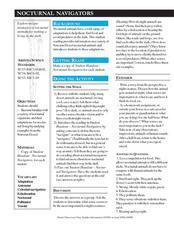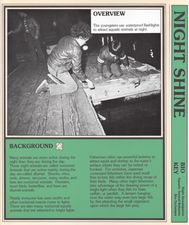ARKive
Nocturnal Animals
How do those nocturnal animals see in the dark? This perplexing question does have an answer. First, little ones use their sense of touch to determine the name of a mystery object, then they listen closely to identify various animals by...
Alabama Learning Exchange
Nocturnal Animals Lesson #4: Owls
Learners investigate the owl food chain. They discuss owl facts, explore various websites, dissect an owl pellet, create a picture of the owl food chain, read the book, "Owl Babies," and write an owl poem.
Curated OER
Daytime/Nighttime Animals
For this Daytime/Nighttime Animals worksheet, students cut out 7 animals and past them in a section labeled "Daytime Animals" or "Nighttime Animals." Students may color in the pictures.
Desert Discoveries
Nocturnal Navigators
Young biologists take a look at some of the unique ways that nocturnal animals survive in the dark. After reading a terrific student handout which is embedded in the plan, learners work together to answer questions about what they have...
Curated OER
Nocturnal vs. Diurnal Animals
First graders identify nocturnal and diurnal animals. In this animal lesson, 1st graders discuss the differences between animals that are active during the day and those that are active at night. Students write summaries about their...
Curated OER
Who's Hooting?
Young scholars in a special education class examine the nocturnal animals in their local area. Individually, they use the internet to research owls and share it with the class. To end the lesson, they use construction paper to make a...
Curated OER
Animals Active at Night
Students identify animals that are active at night and the reasons why. They examine the features needed to be a nocturnal animal. They create a representation of one of the animals.
Curated OER
Night Shine
Students explore aquatic animals that are attracted to light. In this science activity, students observe how aquatic animals respond to light at night. Students search for aquatic animals in the dark and attempt to catch them. Students...
Curated OER
Night Hike
Young scholars explore Upham Woods at night and investigate about the special adaptations of nocturnal animals. They identify three nocturnal animals and how they are adapted to the night. Students explain what night vision is and how it...
Curated OER
Night Eyes
Fifth graders identify nocturnal animals based on specific characteristics. In this animals lesson, 5th graders observe an area at night using flashlights. Students record their findings and discuss as a group.
Curated OER
Who Goes There?
Students discover behaviors of nocturnal animals. In this animal behavior lesson, students conduct a night time experiment with black light tracing materials to observe nocturnal animal behavior in the wild.
Curated OER
"Critters 'R Us" or "Crime Scene Critters"
Students predict, identify, analyze, and categorize the various nocturnal animals found in their immediate area. They set bait around their school, and try to identify the tracks of the animals that eat the food.
Space Awareness
Day and Night in the World
How do different parts of the world experience day and night? Introduce scholars to the concept of global citizenship while teaching about animal behavior with discussion of nocturnal and diurnal animals. Then, learners complete...
Curated OER
Guided Reading "In the Night Sky"
Students participate in a variety of reading exercises, such as choral reading and reading response journal, to reinforce concepts about space and nocturnal animals.
Curated OER
Where Do I Go At Night?
Learners describe the requirements of daytime and nightime animals for survival. They identify any behaviors that assist in the animal surviving. They create a representation for the class to view.
Curated OER
Critters R Us or Crime Scene Critters
Students identify nocturnal animals in their local area. Using the internet, they view animal tracks to determine which ones might be in around their school. In groups, they examine outside areas and record their observations. They...
Curated OER
Blind as a Bat?
Imagine using your ears and voice to see. That is what bats do with echolocation. Demonstrate how echolocation works with this fun game for your classroom. Buzz, buzz!
Alabama Learning Exchange
Introduction to Noctural Animals
Young scholars define noctural and are introduced to a variety of noctural animals. They navigate web sites in order to research noctural animals and write about and illustrate one noctural animal. They create a chart to represent the...
Jessica Winston
Magic School Bus Going Batty
Have a scary adventure with a set of reading activities based on Joanna Cole's The Magic School Bus Going Batty! Several worksheets encourage kids to predict what they will learn with a KWL chart, examine the new vocabulary words from...
Curated OER
The Sonoran Desert
Little learners examine a map of the southwestern United States and identify the Sonoran Desert. They locate different cities and rivers, determining whether or not each is found within this special ecosystem. A student handout is...
Curated OER
Animal Activities: Just the tracks, ma'am
Students learn most urban mammals are nocturnal and are difficult to observe. One of the simplest ways to determine the kinds of animals living in your neighborhod is to track them down.
Curated OER
Bats
Students hypothesize and model how the bones in a bat wing are made up. In this exploratory lesson students test their hypothesis, develop questions about bat parts and watch a video on bats.
Curated OER
Sundials
Students investigate the different types of sundials and their history. In this shadows and time of day lesson students build their own sundials.
Curated OER
We Like to Imagine - Animals
Students describe a pretend animal. They read "The After School Monster." Students read other books and discuss whether or not the characters are real. Students make a drawing of a pretend animal and of a real animal. They make up a...
Other popular searches
- Owls and Nocturnal Animals
- Preschool Nocturnal Animals
- Nocturnal Animals Lessons
- Nocturnal Animals Songs
- Poems for Nocturnal Animals
- K Nocturnal Animals
- Pre K Nocturnal Animals
- List Nocturnal Animals
- Tracks of Nocturnal Animals
- Prue K Nocturnal Animals
- Iowa Nocturnal Animals
- Nocturnal Animals Projects
























